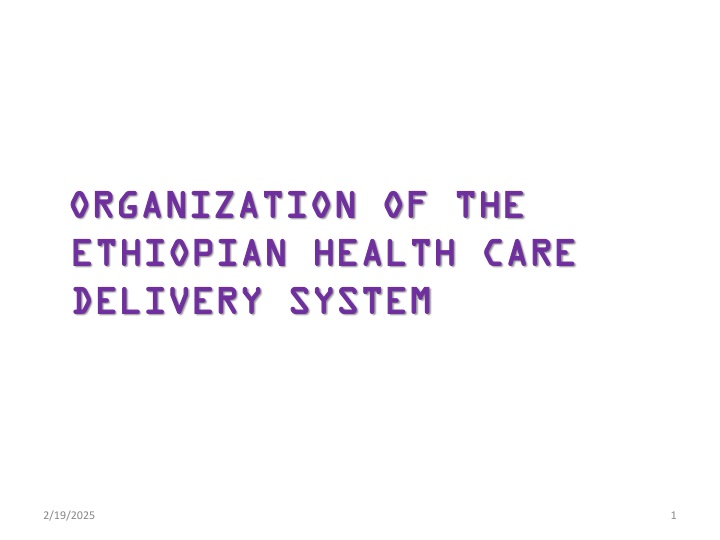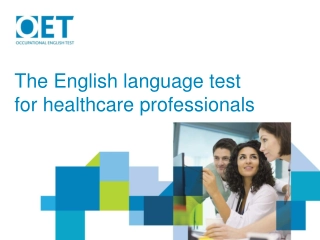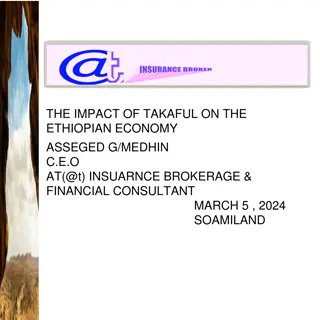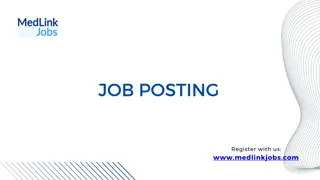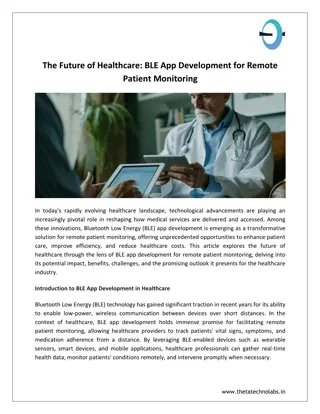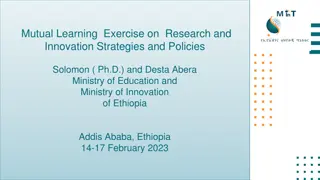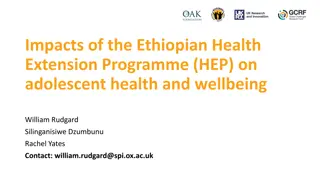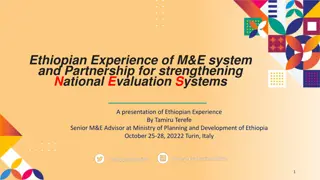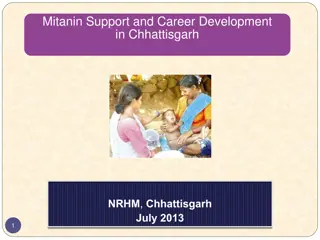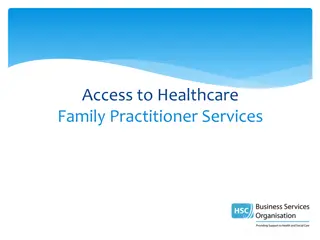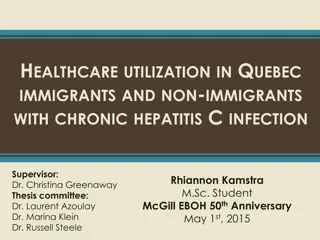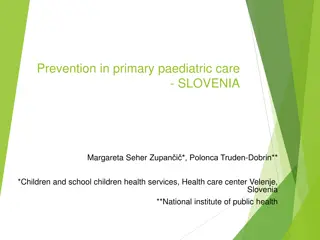Development of Ethiopian Healthcare System
Ethiopia's healthcare system has faced challenges over the years despite historical contributions. From limited government spending to weak infrastructure, the nation is striving to improve its health outcomes. Explore the evolution of healthcare delivery in Ethiopia from ancient civilizations to modern developments.
Download Presentation

Please find below an Image/Link to download the presentation.
The content on the website is provided AS IS for your information and personal use only. It may not be sold, licensed, or shared on other websites without obtaining consent from the author.If you encounter any issues during the download, it is possible that the publisher has removed the file from their server.
You are allowed to download the files provided on this website for personal or commercial use, subject to the condition that they are used lawfully. All files are the property of their respective owners.
The content on the website is provided AS IS for your information and personal use only. It may not be sold, licensed, or shared on other websites without obtaining consent from the author.
E N D
Presentation Transcript
ORGANIZATION OF THE ORGANIZATION OF THE ETHIOPIAN HEALTH CARE ETHIOPIAN HEALTH CARE DELIVERY SYSTEM DELIVERY SYSTEM 2/19/2025 1
Session objectives At the end of this session students will be able to: o Explain historical development of Ethiopian healthcare delivery system o Describe six tier healthcare delivery system o Discuss10 year health plan o Describe priorities of current Ethiopian health policy 2/19/2025 2
Brainstorming Have you ever heard about 6, 4, 3 tiered health delivery system? 2/19/2025 3
Historical development Ethiopia is the second most populous country in Africa Has poor health outcomes even by sub- Saharan Africa s standards Characterized by many decades without a national health policy Weak healthcare system infrastructure and low government spending 2/19/2025 4
Cont In spite of its ancient civilizations and freedom from colonization, Ethiopia today is one of the least developed countries 2/19/2025 5
Cont Modern medicine was introduced to Ethiopia in the 16th century during the regime of Emperor Libne Dingel (1508 1540) Then it was enthusiastically promoted during the reigns of Emperor Menelik II (1889 1913) and Emperor Haile Selassie (1930 1974) 2/19/2025 6
Cont Emperor Menelik invited travellers, missionaries and members of diplomatic missions to introduce medicines and provide medical services, mostly in Addis Ababa The first hospital was established in 1906 2/19/2025 7
Cont The foundation for formalized health service began when the gov t instituted Ministry of Interior in 1908 2/19/2025 8
Cont Emperor Haile Selassie established the Ministry of Public Health in 1947 In 1960 gov t begun to develop basic health services with health center as its backbone 2/19/2025 9
Cont Gondar College of P.H established to train Health Officers, Sanitarians And Community Nurses to staff rural health centers in 1962 In 1963 Ministry of Public Health formulated national policy and strategy for definite health services The first medical school in Addis Ababa was opened in 1966 2/19/2025 10
Cont The monarchial gov t had planned and executed three round 5 years plans The fourth round (1974-1979) was planned focusing on increasing health service coverage from 15 to 30% but not implemented b/c the gov t was sacked 2/19/2025 11
Cont In 1974 Dergue gov tbegun ruling the country 2/19/2025 12
Cont When the Military Junta took over the power there were: 6474 health personnel of all categories 650 health stations 93 health centers 84 hospitals with 8624 beds, and Health service coverage was 15% 2/19/2025 13
Cont The socialist gov t: Declared National Democratic Revolutionary Programme (NDRP) in 1976 NDRP states: o " To ensure full and meaningful life for the broad- masses, all the necessary effort will be under taken to provide adequate health services." 2/19/2025 14
Cont Revised health policy oGave emphasis to PHC & rural health services oPrevention and control of communicable diseases 2/19/2025 15
Cont o Promotion of self reliance and community involvement in health activities In 1978 it had adopted Alma-Ata Declaration of PHC as strategy to achieve Health for All (HFA) by the year 2000 2/19/2025 16
Cont Specific priorities of socialist gov t health policy: Community involvement in development activities including health Coordinate efforts of development sectors having direct or indirect bearing on health promotion The gradual integration of special programme and specialized health institutions 2/19/2025 17
Cont The delivery of essential health care at the cost affordable by the community Development of a 6 tiered health service with levels of increasing technical complexity to facilitate management, referral support, and training 2/19/2025 18
Cont The six-tiered national health care system consists of: Community health services (Health Posts) Health stations (Clinics) Health centers Rural hospitals Regional hospitals and Central referral and teaching hospitals 2/19/2025 19
Cont A. Community Health Service (health post) 1/1000 popn Community Health Agent & Traditional Birth Attendant Performing PHC programmes Referring unresolved matters Reporting, registration of birth & death Participating in studies 2/19/2025 20
Cont B. Health Station (Clinic) 1/10,000 popn 3 Health Assistants Performing PHC programmes Supporting and supervising HPs Minor laboratory services Referring unresolved matters 2/19/2025 21
Cont Participating in training Collecting and reporting health information Participating in Studies C. Health Center 1/50-100,000 popn GP (2), Nurse (3), MCH nurse (2) Sanitarian (2), Lab. Technician (1), Health Assistant (6) Planning and implementing PHC programmes 2/19/2025 22
Cont Participating in training Supporting A and B Compiling health information and reporting Medium level laboratory services Referring unresolved matters Participating in research and studies 2/19/2025 23
Cont .. D. Rural Hospital 1/50-100,000 popn Increased number of professionals in HC + Surgeon, Pharmacists, Anesthetist Nurse, Dental Hygienist, Ophthalmic Assistants, X-ray experts Planning and implementing PHC programmes Participating in training Improve laboratory and X-ray services Supporting "A" "B" and "C" and participating in supervision 2/19/2025 24
Cont Handle Surgical Emergencies Compiling and analysis of health information Referring unresolved matters Participating in research and studies E. Regional Hospital 1/1.6-3 mln popn 2/19/2025 25
Cont Increased number of professionals in rural hospital + Internist, Pediatrician, Gyn-Ob, Ophthalmologist, Radiologist, Physiotherapist, Optometrist . Performing PHC programmes Participating in training Improved laboratory and x-ray services Major speciality services Supporting A , B , C , and D and Participating in supervision 2/19/2025 26
Cont Compiling and analysis of health information Collaborating with Regional Health Department in monitoring and evaluation of health services Conducting research and studies Referring unresolved matters F. Central Hospital Increased number of professionals in RH + dentist, psychiatrist, and other medical specialties 2/19/2025 27
Cont o Performing, strengthening and giving strong support to PHC programmes o Complete laboratory, x-ray and other examinations o Seeking solutions to major health problem o Supporting evaluating and participating in the supervision of health institutions o Conducting serious research and studies 2/19/2025 28
Cont Providing various trainings Compiling, analysing and disseminating health information Reporting 2/19/2025 29
Cont Assessment of 6 tier HCDS indicated that: o Management is very centralized and lacks professionalism o Participation of the community and the private sector is minimal o Undesirable impact on efficiency and resource allocation 2/19/2025 30
Cont o Health service institutions are clustered around their immediate points of supervision (Awraja and regional towns) o Overlapping services around a minor segment of the population 2/19/2025 31
Cont Annual campaigns (1979-1985) Aimed at overcoming urgent problems in all sectors including health esp. in rural areas Implemented by high school and university students Outcomes have been encouraging in solving the urgent social and economic problems Construction of thousands of wells and latrines 2/19/2025 32
Cont o Community health services (HPs) introduced in more than 5000 localities o Health station tripled from 650 to 1950 o Health centers increased from 93 in 1974 to 145 in 1985 2/19/2025 33
Cont The Ten Year Health Sector Plan (1985-1994) It was the part of the over all process to achieve the goal of health for all by the year 2000 based on the principles of PHC through: o Promotion of health o Prevention of disease and o Reduction of morbidity and mortality 2/19/2025 34
Cont Objectives of 10 year plan To foster full and active community involvement in health activities To ensure multi-sectoral collaboration and coordination in all health actions Extend health services to where the broad masses live and work Put under control all major communicable diseases 2/19/2025 35
Cont Expand EPI services to ensure a wide coverage of the population Ensure provision of HS to mothers, children, students, under privileged nationalities, workers etc To extend medical service to 80% of the population 2/19/2025 36
Cont Main targets of the plan o Reduction infant mortality (IMR) from 155/1000 to 95/1000 o Reduction of child mortality rate from 247/1000 to 95/1000 o Improvement of life expectancy at birth from 42 years to 55 years 2/19/2025 37
Cont To achieve the targets the gov t set intermediate actions: Training of health workers for all levels of health services Development of supportive institutions, such as the MCH center Improving resource capacity Improving of property management skills 2/19/2025 38
Cont Maintenance and construction capacity for buildings, medical equipment, vehicles Organizing and strengthening traditional medicine Expanding EPI, nutrition education, medical screening, school health service Control and prevention of communicable diseases. 2/19/2025 39
Cont Provision of environmental health services and clean water to include 80% of the rural popn To increase health awareness of the population- through continuous HIE 2/19/2025 40
Example of plan for training health professionals Type of Medical Personnel GP Available in 1984 Plan for 1994 721 2,000 Specialists 349 819 Nurses (All types) Sanitarians Lab. Tech. 1,960 298 425 5,498 1,962 1,209 2/19/2025 41
Cont X-ray Tech. 138 183 Pharmacy Attendants 150 646 Health Assistants 6,991 13,500 CHA 31,500 TBA-trained 33,000 2/19/2025 42
Cont The 10 year health plan had several shortcomings: o Unrealistic goals o Under funding o Inefficient utilization of resources o Unsuitable organizational structures o The plan remained unattended as the government was primarily pre-occupied by political conflicts and war 2/19/2025 43
Health policy of Transitional Government of Ethiopia 2/19/2025 44
Group discussion What is policy? Its importance? What are the priorities of current Ethiopian health policy? 2/19/2025 45
Cont o A policy is a deliberate plan of action to guide decisions and achieve rational outcome(s). o It is a predetermined course of action established as a guide toward accepted organizational strategies & objectives o It is a general guideline that regulates different activities o In 1993 Ethiopian transitional government has endorsed the health policy for the country 2/19/2025 46
Cont Priority areas of the 1993 TGE health policy o Information, Education and Communication (I.E.C) of health to enhance self-responsibility among people o Emphasis on: Control of communicable diseases, epidemics, malnutrition Promotion of occupational health & safety Development of env tal health, health infrastructure, HSM system 2/19/2025 47
Cont o Appropriate support shall be given to the curative and rehabilitative components of health including mental health o Due attention shall be given to the development of the beneficial aspects of Traditional Medicine including related research and its gradual integration into Modern Medicine. o Applied health research addressing the major health problems shall be emphasized 2/19/2025 48
Cont o Provision of essential medicines, medical supplies and equipment shall be strengthened o Development of human resources with emphasis on expansion of the number of frontline and middle level health professionals with community based, task oriented training shall be undertaken 2/19/2025 49
Cont o Special attention shall be given to the health needs of:- The family particularly women and children Those in the forefront of productivity Most neglected regions and segments of the population (rural population, pastoralists, the urban poor and national minorities) Victims of man-made and natural disasters 2/19/2025 50
